What is Fenugreek by DK on Dec 24, 2011
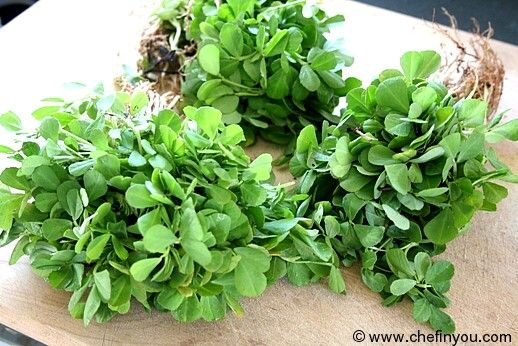 Alternate Names
Fenugreek is also known as Methya (in Marathi), menthya (in Kannada), Vendayam (in Tamil), Menthulu (in Telugu), Uluva (in Malayalam) , Uluhaal ( in Sinhalese), Methi ( (In Oriya,Bangla, Punjabi, Urdu and Hindi). In Persian it is Shanbalîleh, and in Arabic its name is Hilbeh.
What is Fenugreek?
Fenugreek belongs to the plant family "Fabaceae". It is available and used both as a herb (the leaves of the plant) and as spice (the seed). It is cultivated worldwide as a semi-arid crop. It is frequently used in curry and is a very famous Indian leafy vegetable which resembles clover leaves. It has a very light bitter taste (which might require getting used to) and has a spicy taste to it.
How to Prepare Fenugreek Leaves
The fresh leaves undoubtedly have lots of mud and debris in them. Hence cleaning is v essential. Before that, chop off the roots of the leaves.
Alternate Names
Fenugreek is also known as Methya (in Marathi), menthya (in Kannada), Vendayam (in Tamil), Menthulu (in Telugu), Uluva (in Malayalam) , Uluhaal ( in Sinhalese), Methi ( (In Oriya,Bangla, Punjabi, Urdu and Hindi). In Persian it is Shanbalîleh, and in Arabic its name is Hilbeh.
What is Fenugreek?
Fenugreek belongs to the plant family "Fabaceae". It is available and used both as a herb (the leaves of the plant) and as spice (the seed). It is cultivated worldwide as a semi-arid crop. It is frequently used in curry and is a very famous Indian leafy vegetable which resembles clover leaves. It has a very light bitter taste (which might require getting used to) and has a spicy taste to it.
How to Prepare Fenugreek Leaves
The fresh leaves undoubtedly have lots of mud and debris in them. Hence cleaning is v essential. Before that, chop off the roots of the leaves.
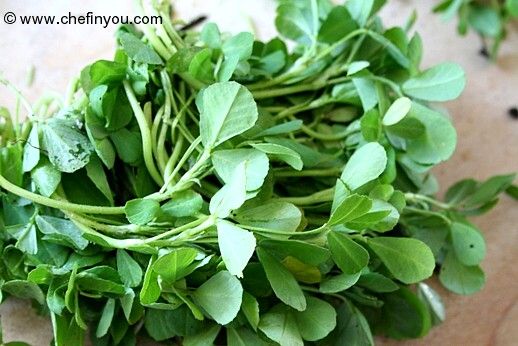 Pick the leaves of the stem. Very tender stems can be left in.
Pick the leaves of the stem. Very tender stems can be left in.
 Wash very well in cold water. It might take time but you don't want mud in your food. Its worth it though.
Wash very well in cold water. It might take time but you don't want mud in your food. Its worth it though.
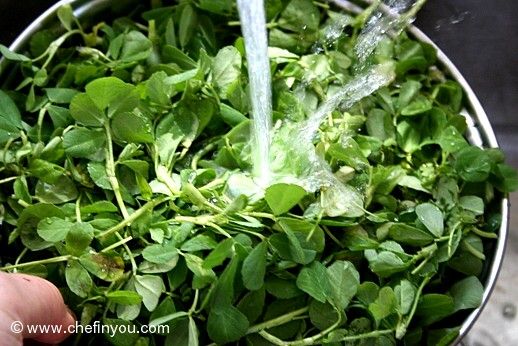 Chop it lightly and coarsely. You can now use this in varied recipes.
Chop it lightly and coarsely. You can now use this in varied recipes.
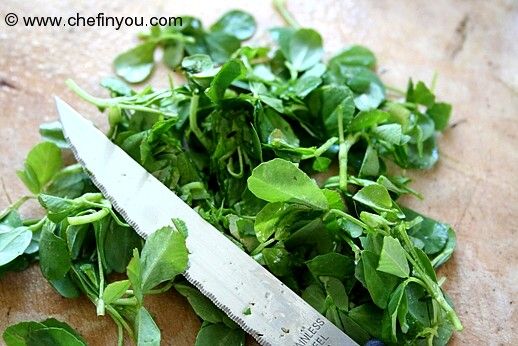 These are mostly available in Indian stores. The fresh leaves can be hard to come by in which case try checking the freezer section. Many Indian stores now carry the frozen version of the same. The frozen can be a boon in the sense it cuts out the preparation time (which can be quite time consuming depending in the amount you plan to use). Simply thaw and use it in the recipe.
Different Types and Availibility
Fenugreek is mainly available in 3 forms:
1. Fenugreek leaves
2. Dried Fenugreek leaves (also commonly referred to as Kasuri Methi)
3. Seeds
Almost all Indian stores would definitely carry the dried Fenugreek and the seed since they are essential Indian spices used commonly in the cuisine. The fresh leaves may be hard to come by in which case check for frozen leaves (nowadays quite a common sight in the Indian shops) or substitute with the dried version ( 1/3 rd of the original amount)
These are mostly available in Indian stores. The fresh leaves can be hard to come by in which case try checking the freezer section. Many Indian stores now carry the frozen version of the same. The frozen can be a boon in the sense it cuts out the preparation time (which can be quite time consuming depending in the amount you plan to use). Simply thaw and use it in the recipe.
Different Types and Availibility
Fenugreek is mainly available in 3 forms:
1. Fenugreek leaves
2. Dried Fenugreek leaves (also commonly referred to as Kasuri Methi)
3. Seeds
Almost all Indian stores would definitely carry the dried Fenugreek and the seed since they are essential Indian spices used commonly in the cuisine. The fresh leaves may be hard to come by in which case check for frozen leaves (nowadays quite a common sight in the Indian shops) or substitute with the dried version ( 1/3 rd of the original amount)
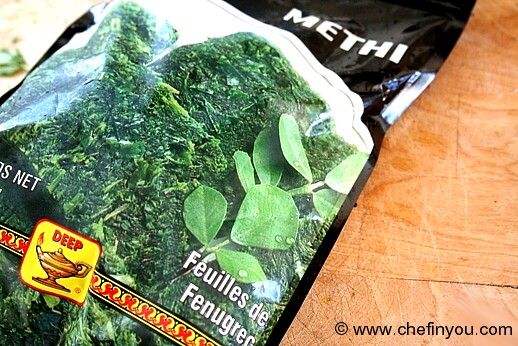 The Fenugreek seeds play a intimate role in so many dishes in the Indian cuisine. Be it from aromatic powders, or simple day to day lentil dishes to the extent of adding a special touch to traditional rice recipes. The seeds can be sprouted and enjoyed in salads, can be seeped in hot water and enjoyed as Tea, so on and so forth,
The Fenugreek seeds play a intimate role in so many dishes in the Indian cuisine. Be it from aromatic powders, or simple day to day lentil dishes to the extent of adding a special touch to traditional rice recipes. The seeds can be sprouted and enjoyed in salads, can be seeped in hot water and enjoyed as Tea, so on and so forth,
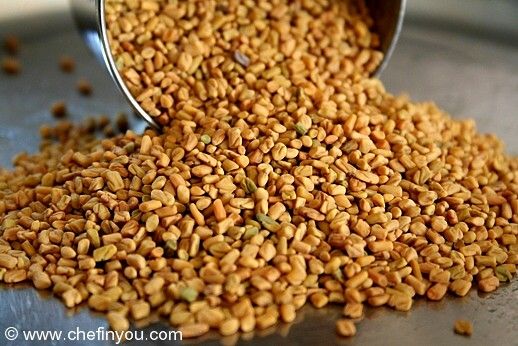 Benefits of Fenugreek
The benefits are multitude. The seeds have been found to contain protein, vitamin C, niacin, potassium, and diosgenin (which is a compound that has properties similar to estrogen). Due to its estrogen-like properties, fenugreek has been found to
- help increase libido and lessen the effect of hot flashes and mood fluctuations that are common symptoms of menopause and PMS.
- to treat arthritis, asthma, bronchitis, improve digestion,
- maintain a healthy metabolism, increase libido and male potency,
- to cure skin problems (wounds, rashes and boils),
- to treat sore throat, and cure acid reflux.
Fenugreek also has a long history of use for the
- treatment of reproductive disorders,
- to induce labor,
- to treat hormonal disorders,
- to help with breast enlargement, and
- to reduce menstrual pain.
Recent studies have shown that Fenugreek helps lower blood glucose and cholestrol levels, and may be an effective treatment for both type 1 and 2 diabetes. Fenugreek is also being studied for its cardiovascular benefits.
What are the Side Effects of Fenugreek?
It is generally considered safe when used moderately although there have been reports which mention few very minor side effects.
- Nausea
- gastrointestinal discomfort (diarrhea and/or gas)
- Use of fenugreek is not advised if you are pregnant since its known to induce labor. Consult with your doctor.
- If you are consuming any oral medications then it is important to use fenugreek at least 2 hours before or after these drugs since the fiber in Fenugreek has the potential to interfere with the absorption of oral medications due to its mucilaginous fiber (which gives it a moist and sticky texture).
Substitutes for Fenugreek
Dried leaves, either whole or ground are a good substitute for fresh. Replace with half the qty of fresh. If both are not available the one closest would be celery leaves since it also has a slight bitter taste similar to Fenugreek. You can also use chopped watercress leaves. For the seeds, substitute 1 tsp fenugreek seeds with 1 tsp yellow mustard seeds.
How and Where to Buy Fenugreek
Fenugreek is often available in capsules, seed, and powder form at many health food stores. Fenugreek seeds can also often be found at Indian/Pakistani grocery stores. You may also be able to find Fenugreek herbal tea bags.
Fenugreek Recipes
1. Recipes with Fenugreek leaves
2. Recipes with Dried Fenugreek leaves (also commonly referred to as Kasuri Methi)
3. Recipes with Fenugreek Seeds
References
1. http://www.homeremediesweb.com/fenugreek_health_benefits.php
2. http://www.herbwisdom.com/herb-fenugreek.html
3. http://www.vitaminstuff.com/herbs-fenugreek.html
4. http://www.organicfacts.net/health-benefits/vegetable/health-benefits-of-fenugreek.html
5. http://www.herbal-supplements-guide.com/fenugreek-seed-uses.html
Benefits of Fenugreek
The benefits are multitude. The seeds have been found to contain protein, vitamin C, niacin, potassium, and diosgenin (which is a compound that has properties similar to estrogen). Due to its estrogen-like properties, fenugreek has been found to
- help increase libido and lessen the effect of hot flashes and mood fluctuations that are common symptoms of menopause and PMS.
- to treat arthritis, asthma, bronchitis, improve digestion,
- maintain a healthy metabolism, increase libido and male potency,
- to cure skin problems (wounds, rashes and boils),
- to treat sore throat, and cure acid reflux.
Fenugreek also has a long history of use for the
- treatment of reproductive disorders,
- to induce labor,
- to treat hormonal disorders,
- to help with breast enlargement, and
- to reduce menstrual pain.
Recent studies have shown that Fenugreek helps lower blood glucose and cholestrol levels, and may be an effective treatment for both type 1 and 2 diabetes. Fenugreek is also being studied for its cardiovascular benefits.
What are the Side Effects of Fenugreek?
It is generally considered safe when used moderately although there have been reports which mention few very minor side effects.
- Nausea
- gastrointestinal discomfort (diarrhea and/or gas)
- Use of fenugreek is not advised if you are pregnant since its known to induce labor. Consult with your doctor.
- If you are consuming any oral medications then it is important to use fenugreek at least 2 hours before or after these drugs since the fiber in Fenugreek has the potential to interfere with the absorption of oral medications due to its mucilaginous fiber (which gives it a moist and sticky texture).
Substitutes for Fenugreek
Dried leaves, either whole or ground are a good substitute for fresh. Replace with half the qty of fresh. If both are not available the one closest would be celery leaves since it also has a slight bitter taste similar to Fenugreek. You can also use chopped watercress leaves. For the seeds, substitute 1 tsp fenugreek seeds with 1 tsp yellow mustard seeds.
How and Where to Buy Fenugreek
Fenugreek is often available in capsules, seed, and powder form at many health food stores. Fenugreek seeds can also often be found at Indian/Pakistani grocery stores. You may also be able to find Fenugreek herbal tea bags.
Fenugreek Recipes
1. Recipes with Fenugreek leaves
2. Recipes with Dried Fenugreek leaves (also commonly referred to as Kasuri Methi)
3. Recipes with Fenugreek Seeds
References
1. http://www.homeremediesweb.com/fenugreek_health_benefits.php
2. http://www.herbwisdom.com/herb-fenugreek.html
3. http://www.vitaminstuff.com/herbs-fenugreek.html
4. http://www.organicfacts.net/health-benefits/vegetable/health-benefits-of-fenugreek.html
5. http://www.herbal-supplements-guide.com/fenugreek-seed-uses.html Browse By these popular categories
- 154 Baking
- 287 Course
- 366 Cuisine
- 206 Healthy Foods
- 44 How to's
- 6 Instant Pot Recipes
- 1 Kid Friendly Recipes
- 94 Occasions
- 18 OPOS- One Pot One Shot Recipes
- 1 Slow Cooker Recipes
- 24 Special Diets
- 3 Student/Bachelor Cooking Recipes
Recent Articles by ChefInYou
Ganesh Chavithi ( Vinayaka Chaturthi) Festival 2020 Recipes By DK on Aug 16, 2020
Krishna Jayanthi | Gokulashtami Festival Recipes By DK on Aug 8, 2020
OPOS Lessons: How to Standardise your Pressure cooker? By DK on Jan 28, 2019
6 things I never thought I will ever do! By DK on Aug 1, 2018
Super Bowl Recipes 2018 By DK on Jan 28, 2018
7 Ways OPOS® Cooking Improved My Life By DK on Nov 19, 2017
Prepping Staples – Planning my Weekly Menu By DK on Nov 13, 2017
6 Quick & Healthy After School Snacks (with Variations) By DK on Sep 6, 2017
Bell Peppers (Capsicum): Planting, Growing & Harvesting for Beginners By DK on Aug 9, 2017
OPOS® – Frequently Asked Questions By DK on Jul 21, 2017
Recent Posts by ChefInYou
Instant pot Applesauce By DK on Nov 30, 2020
Vegetable Pulao using RightRice By DK on Oct 28, 2020
Classic Oatmeal using Sprouted Rolled Oats By DK on Oct 21, 2020
Pita Tostada By DK on Oct 14, 2020
Green Chutney / Hari Chutney (Chaat) By DK on Oct 7, 2020
Leave a Reply
I love to hear from you! I read each and every comment, and will get
back as soon as I am able to.
24 Comments
By serah minayo on Jul 31, 2016
This veggie is also grown in Kenya East Africa (more likely in Western Kenya) We have two kinds one that has bitter taste has wider leaves as shown in the picture the other is not so bitter very mild bitterness if any and the leaves are long and very slim/narrow. It is a good veggie because you do not need oil or even salt you can just boil it and eat it with ugali (fufu). Traditionally it is cooked with african home made salt (which is filtrate from ashes of maize cobs and/or dry beanstalks (after harvesting and removing dry beans). The filtrate tastes like salt, it also cooks the veggie soft and often used in meats to make it tender so it is like a meat tenderizer as well. It also minimizes the bitter taste of the veggie. So it is very healthy veggie and easy to grow. The seeds are very cheap and in my community you can easily get them for free. It is called "Mito"
By Tessy on Jun 2, 2016
Where will I get fenugreek seeds in Namibia?
By Leena on Apr 13, 2016
Can kidney patients have fenugreek leaves & seeds i have nephropathy please let me know thank you
By Jimoh on Feb 18, 2016
Where in Lagos Nigeria can these seeds be bought? Please send the address.
By ratna khadka on Jan 3, 2016
can kidney patient have fenugreek leaves and seed
By ratnakhadka on Jan 3, 2016
can kidney patient have fenugreek leaves as well as seed
By Abdulkareem on Jun 14, 2015
Its available on all indian and pakistan shops....also u can ask another name kasturi methi
By Hope on May 19, 2015
please notify where I can find fenugreek seeds, or powder or cream or leaf in Niger State please.
By solange on Dec 30, 2014
:?: where can i get fenugreek leaves in Cameroon - Douala
By nina on Oct 8, 2014
SHOUld fenugreek leaves be eaten or seeds with cold water in the morning for breast enhancement
:?:
By Gaman on Jul 31, 2014
I take reguarly these seeds and I feel better.
By Annie on Jul 14, 2014
where can i get fenugreek seed in Nigeria?
How much does it cost? am in Enugu 8)
By adenike on Jul 4, 2014
Pls tell me where I can get fenugreek seeds or powder in Nigeria?
By Mac on Apr 23, 2014
Fenugreek is an English name it is very commonly available in India and is a major ingredient in Indian food. It may be available in stores selling Indian items worldwide. It can be grown easily as follows. Fill a coffee mug ( For experimental purpose ) with sand and put some Fenugreek seeds ( 10 - 15 ) and water it moderately, it grows in 5 -6 days so as it can be consumed.
By Vivian on Mar 23, 2014
Pls where can I get fenugreek powder in lagos Nigeria?
By Rama on Mar 4, 2014
You can get this in leafs and vegetable market
By Maria on Feb 1, 2014
How do you use it in cooking :?: I also heard that it helps with Dementia : :-P
By Aditya on Jan 11, 2014
Have 15 fenu greek in moring with cold water.. thats the best way to ncrease breast..
By DeAndra on Jan 4, 2014
What is the best way to use fenugreek as a breast enhancer? And what strength works best?
By Ismail Gulaid on Oct 11, 2013
wwonderful natural remedy(fenugreek)
thank God for that
By chi on Jun 3, 2013
where and how can i get fenugreek in Nigeria. Secondly is fenugreek an English name?if no what is the English name and how can i identify it
:?:
By ann on May 11, 2013
How do i get fenugreek leaf and seed. Mobile number 08020712874 nigeria
By ann on May 11, 2013
How do i get fenugreek leaf and seed





By Bala Alkkas on Feb 1, 2017